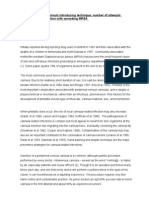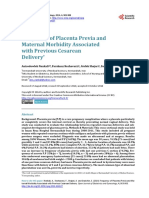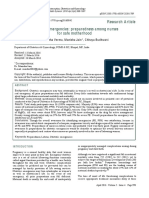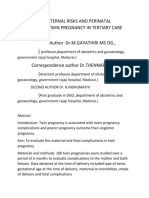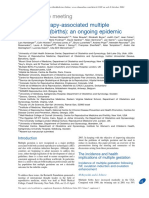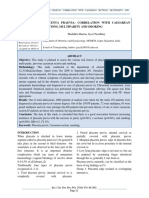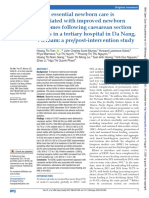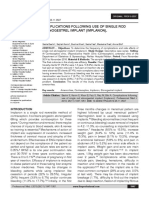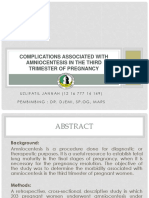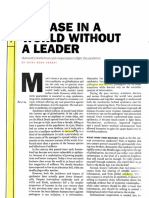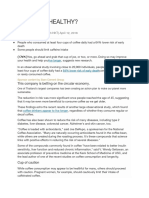FRC
FRC
Uploaded by
Fino GunnersCopyright:
Available Formats
FRC
FRC
Uploaded by
Fino GunnersOriginal Description:
Original Title
Copyright
Available Formats
Share this document
Did you find this document useful?
Is this content inappropriate?
Copyright:
Available Formats
FRC
FRC
Uploaded by
Fino GunnersCopyright:
Available Formats
Medicine Science 2012;1(3):171-6 Outlet Forceps in Modern Era
doi: 10.5455/medscience.2012.01.8018
Outlet Forceps in Modern Era, a Dangerous Instrument or an Art of
Obstetrics?
Gunvant Vaishnav1, Jolly Vaishnav2
1
Department of Obstetrics and Gynecology, Government Medical College, Baroda, India
2
Department of Pediatrics,Government Medical College, Baroda, India
Abstract
Aim of this study was to assess feto maternal outcome in outlet forceps delivery. 69 patients in
the Labour room who delivered by outlet forceps at Dept. of Obs. and Gyn. Medical college,
Baroda, India were analyzed for Feto maternal outcome. Incidence of Wrigley’s outlet
forceps delivery is 0.74% in our study. 78.26% were applied for primipara, as may be due to
rigid perineum in primipara. 71 % in the age group of 16-25 years, common age of
primipara. Age and obstetric outcome it is observed that operative interference is required
frequently. Indications of forceps were also comparable with common indications with others.
68.12% baby with normal APGAR scoring. While 2.90% develop Severe Birth Asphyxia and
11.59% required Nursery admission while 15.94% required resuscitation at the time of birth,
these shows that with forceps delivery the outcome is comparable to the vaginal delivery.
Impression marks over face, abrasion over face are also comparable. Only one neonatal
death occurred that was due to Neonatal septicaemia and 4.35% develop cephalhematoma
which is slightly higher. The vaginal and cervical tear rates are also comparable. Only Two
Patients develop PPH, one (1.45%) traumatic, while other (1.45%) develop Atonic PPH
which are comparable to normal vaginal delivery and even after Caesarean section delivery.
Only 1.45% patients develop urinary incontinence. Study performed using Wrigley’s outlet
forceps application using ACOG guidelines, 2002/2011. We conclude that maternal and
foetal outcome are comparable good with the vaginal delivery. Indicated forceps delivery can
reduce the caesarean section rate. No major maternal or foetal morbidity / mortality found
due to forceps in study group. We feel that the entire young obstetrician colleague must know
the applications of forceps and should implement in practice to decrease the caesarean
section rates. Even nowadays Government of India in BEmoc training for Medical Officer
(MBBS) in service included the forceps and vaccume delivery in the training course so as to
teach them the skill. So that they can help the Nation in lower down the Maternal Mortality
Rate. So, we can say that the forceps application with all criteria’s fulfilled in a expert hand
is an Art of Obstetrics and not a dangerous Instruments.
Keywords: outlet forceps, foetal complications, maternal complications
(Rec.Date: Jun 06, 2012 - Accept Date: Jun 30, 2012)
Corresponding Address: Gunvant Vaishnav, MD, Government Medical College,
Department of Obstetrics and Gynecology, Baroda, India
E-mail: gunvant.vaishnav@yahoo.com
www.medicinescience.org | Med-Science 171
Medicine Science 2012;1(3):171-6 Outlet Forceps in Modern Era
doi: 10.5455/medscience.2012.01.8018
Introduction
The status of forceps is constantly under discussion with in the speciality, and with paediatrics
colleague, controversy is always there and the effort for the improvement in the results. In old
Sanskrit it is k/a Golden instrument, but real art of forceps was born by Peter chamberlain in
1600 A.D. Even after 300 years it survived till today in modern Obstetrics. The forceps have
improved the maternal and foetal salvage, of course with proper selection of patients, forceps,
and their applications [1]. The Obstetric Outlet Forceps applications is used in the interest of
the mother and/or baby and when properly performed can be rewarding experience and also
life savings [2, 3]. There are varieties of forceps available, but high forceps, mid cavity, and
rotational forceps has a no role in modern obstetrics [4]. Now a days only outlet forceps
should be used even, we found that rate of forceps delivery is declining with a fear of
maternal trauma and/or foetal injuries, and a long term sequele of the foetal growth and
development, which requires a large long term prospective study to determine the foetal
growth and development [4]. Outlets forceps with medio lateral episiotomy has been
demonstrated to give foetal and maternal results the equal if not exceed those of spontaneous
vertex deliveries [1,5].
Method
The study was conducted at Department of Obstetrics and Gynaecology Medical College,
Baroda, Gujarat, from June 2009 to May 2011. All the cases were admitted as indoor patients
in our hospital, present study was carried out with different aims and aspects like age, parity
of patients, indications and type of forceps, maternal and foetal complications. This was a
Clinical observational type of study with consent from patients. Wrigley’s outlet forceps
application done using ACOG guideline-2002 [4]. Exclusion criteria are: gross CPD, Station
of head in relation to Ischial spine <+ 2, not well rotated. All cases studied keeping the above
different aspects in mind.
www.medicinescience.org | Med-Science 172
Medicine Science 2012;1(3):171-6 Outlet Forceps in Modern Era
doi: 10.5455/medscience.2012.01.8018
Table 1. Incidence of forceps delivery
Incidence ACOG[4]2011
Total Nos. of 9255
Deliveries
Total outlet forceps 69 0.74% 0.8%
delivery
Table 2. Distribution of patients according to age and parity
Parity Distribution Age Distribution
Numbers Percentage Age in years No. of Percentage
forceps
delivery
Primi Para 54 78.26% 16-20 20 28.99 %
Second Para 9 13.04 % 21-25 29 42.02 %
Third Para 5 7.25 % 26-30 14 20.29 %
Multi Para 1 1.45 % >30 06 8.70 %
Table 3. Distribution of patients according to indications
Indications No. of forceps Percentage Johnson et al [3]
delivery
Foetal Distress 21 30.43 % 47.1 %
Prolonged 2nd stage of 11 15.94 % 14.0 %
labour
Maternal distress 09 13.04 % 38.5 %
Previous LSCS 03 4.34 %
Severe PIH 08 11.59 %
Ecclampsia 02 2.90 %
Cardiac Disease 02 2.90 %
Anaemia 12 17.39 %
Asthma 01 1.45 %
www.medicinescience.org | Med-Science 173
Medicine Science 2012;1(3):171-6 Outlet Forceps in Modern Era
doi: 10.5455/medscience.2012.01.8018
Table 4. APGAR scoring and NICU admission
APGAR scoring NICU admission
APGAR score at No of cases Percentage Neonatal No. of cases Percentage
1 minute
7-10 47 68.12 % Neonatal 08 11.59 %
admission
4-6 20 28.98 % Neonatal 11 15.94 %
resuscitation
0-3 02 02.90 %
Table 5. Maternal injuries and complications.
Maternal injuries Maternal complications
Perineal Tear complications No of Percentage
1st 2 2.90% cases
Degree 3 4.35% Third Stage
2nd complications 01 1.45 %
Degree Atonic PPH 0 -----
Vaginal Tear 5 7.25% Secondary 01 1.45 %
PPH
Traumatic
PPH
Multiple 2 2.90% 24% Infections
Tear Yancey.[5] Episiotomy 03 4.35 %
infection 04 5.80 %
UTI
Para urethral 2 2.90% Incontinence
Extended 4 5.80% Urinary 1 1.45 %
Episiotomy Fecal 0
Table 6. Birth injuries
Birth injuries No of cases Percentage
Impression marks 6 8.69 %
Abrasion on face 4 5.80 % 5% Hagadan et al
Cephal hematoma 3 4.35 % 2% Dell et al
Early Neonatal Death 1 1.45 %
www.medicinescience.org | Med-Science 174
Medicine Science 2012;1(3):171-6 Outlet Forceps in Modern Era
doi: 10.5455/medscience.2012.01.8018
Results
We had analysed 69 patients who delivered by Wrigley’s outlet forceps application using
ACOG guidelines-2002 [4]. During the study period the total Nos. of deliveries were 9255
and the forceps incidence was 0.74% which is quite comparable to the ACOG 2011
guidelines-2011 ,is 0.8% .[4].
The majority 78.26% (54) forceps were applied for the primipara, while 13.04% (9) for
second Para. As may be due to rigid perineum in primipara, and the 71% (49) were applied in
the age group of 16-25 years which is the common age of majority of primipara. Significance
of age and obstetrics outcome it is observed that operative interference is required frequently.
Out of 69 cases 30.43 % were for foetal distress, 15.94% were for prolonged 2nd stage of
labour 13.04% were for maternal distress, 4.34 %, previous LSCS, 11.59 %, severe PIH,
17.39% for anaemia were the common indications of forceps, while 2.90 % for ecclampsia,
4.34 % were done for the medical disorders i.e. Cardiac Disease and Asthma. Prophylactic
forceps were used in Prev. CS, S.PIH, Ecclampsia, Heart disease, Anaemia are the
commonest recommended indications [3, 4]. Also in our study 68,12% with normal APGAR
scoring of 7-10 while only 2.90% (2) had only Severe Birth Asphyxia and only 11.59%(8)
required neonatal nursery admission, while 15.94% (11) required resuscitation at time of
birth , these shows that forceps delivery the outcome is comparable to the vaginal delivery [5].
8.69% (6) had a impression marks over face, while 5.80 % (4) had abrasion over face which is
comparable to 5% in a study in which only one neonatal death occurred due to Neonatal
septicaemia and 4.35% (3) develop cephal hematoma which is slightly higher than study of
Dell et al, showed 2% only [6]. 7.25% (5) developed 1st/2nd degree perineal tear, 7.25% (5)
developed vaginal tear, 2.90% (2) developed multiple tear which is very much less than the
study of Yancey, showed 24%. Only 5.80% (4) developed extension of episiotomy, while
4.35% (3) develop episiotomy wound infections, which is even seen in normal vaginal
delivery with same rate. Two Patients developed PPH, one (1.45%) traumatic, while other
(1.45%) developed Atonic PPH which is comparable to normal vaginal delivery and even
after Caesarean section delivery [5]. One patient (1.45%) developed urinary incontinence.
Thus purpose of using the outlet forceps is to protect the baby and help the mother to cut short
the second stage of labour [1,3].
www.medicinescience.org | Med-Science 175
Medicine Science 2012;1(3):171-6 Outlet Forceps in Modern Era
doi: 10.5455/medscience.2012.01.8018
Conclusion
We can conclude that Obstetrics forceps has a significant place in Obstetrics. As it is
lifesaving procedure for mother and foetus in many situations. In skilled hand it is very safe
and important to cut short of 2nd stage of labour or even prophylactic use also. Successful
result can be achieved more only “By skill and not by force “
Sound clinical evaluation and adherence to the ground rule and a skill of operator will
minimize the risk of failure and complications. Using outlet forceps the overall rates of
maternal and perinatal morbidity and mortality are negligible and even comparable to
spontaneous vaginal delivery.
Over the years Caesarean delivery rate has increased while instrumental delivery rate has
fallen dramatically over past decade, ACOG-2011 recommends forceps delivery as an
acceptable and safe option for Delivery. Outlet forceps plays an very important role in
obstetrics practice and remain appropriate tools in the armamentarium of the modern
obstetrics, so in modern obstetrics outlet forceps is having a definitive role.
All the young obstetricians must have a knowledge and confidence in applying the
instrumental vaginal deliveries. Even nowadays Government of India in BEmoc training for
Medical Officer in service (MBBS) included the forceps and vacuum delivery in the syllabus
to teach them. So, they can help the Nation in decreasing in the Maternal Mortality Rate.
References
1. Dennen PC. Dennen’s Forceps Deliveries 3rd ed, Davis Company, F. A, New York,
1989;188.
2. American College of Obstetrics and Gynecology. Operative vaginal delivery. Clinical
management guidelines for obstetrician-gynecologists. American College of Obstetrics
and Gynecology. Int J Gynaecol Obstet. 2001;74(1):69-76.
3. Johnson JH, Figueroa R, Garry D, Elimian A, Maulik D. Immediate maternal and neonatal
effects of forceps and vacuum-assisted deliveries. Obstet Gynecol. 2004;103(3):513-8.
4. ACOG Medical Teaching /Module 2011 forceps incidence in modern Era.
5. Yancey MK, Herpolsheimer A, Jordan GD, Benson WL, Brady K. Maternal and neonatal
effects of outlet forceps delivery compared with spontaneous vaginal delivery in term
pregnancies. Obstet Gynecol. 1991;78(4):646-50.
6. Dell DL, Slightler SE, Plauche WC. Soft cup vacuum extraction: a comparison of outlet
delivery. Obstet Gynecol 1985;66:624–8.
7. Government of India’s Guidelines for BEmoc training for Medical officers - 2009.
www.medicinescience.org | Med-Science 176
You might also like
- Obstetric Emergencies PDFDocument4 pagesObstetric Emergencies PDFtanmai nooluNo ratings yet
- Department of Education: Republic of The PhilippinesDocument10 pagesDepartment of Education: Republic of The PhilippinesArnold A. Baladjay100% (1)
- A Study of Intrauterine Fetal Death in A Tertiary Care HospitalDocument4 pagesA Study of Intrauterine Fetal Death in A Tertiary Care HospitalintanNo ratings yet
- 2020 - Obstetric Referral Pattern in A Tertiary Care Centre A Prospective Observational Study, IndiaDocument7 pages2020 - Obstetric Referral Pattern in A Tertiary Care Centre A Prospective Observational Study, IndiaTaklu Marama M. BaatiiNo ratings yet
- Peripheral Venous Cannula Introducing Technique and MRSA InfectionDocument8 pagesPeripheral Venous Cannula Introducing Technique and MRSA InfectionDr Kadiyali M Srivatsa100% (2)
- A Retrospective Study On Ectopic Pregnancy: A Two Year StudyDocument4 pagesA Retrospective Study On Ectopic Pregnancy: A Two Year StudyGung GiscaNo ratings yet
- Faysal Bas It,+86-89-MinDocument4 pagesFaysal Bas It,+86-89-MinIT RSMPNo ratings yet
- Study of Pregnancy Outcome of Threatened AbortionDocument6 pagesStudy of Pregnancy Outcome of Threatened AbortionDeepak YadavNo ratings yet
- Paper1 EJMCM_Volume 9_Issue 2_Pages 2008-2012Document5 pagesPaper1 EJMCM_Volume 9_Issue 2_Pages 2008-2012Deepak ThakkerNo ratings yet
- Pre and Post Conception Risk Factors in PROM: Research ArticleDocument5 pagesPre and Post Conception Risk Factors in PROM: Research ArticleNurul ImaniarNo ratings yet
- Journal Ruptured Ectopic Pregnancy, The Challenges For The ObstetricianDocument5 pagesJournal Ruptured Ectopic Pregnancy, The Challenges For The ObstetricianEricNo ratings yet
- 1 PDFDocument7 pages1 PDFAlfa FebriandaNo ratings yet
- Codigo RojoDocument32 pagesCodigo RojoradiolafiesteraNo ratings yet
- 1577-Article Text-3940-1-10-20170710Document12 pages1577-Article Text-3940-1-10-20170710aghniajolandaNo ratings yet
- Ojog 2014102311015160 PDFDocument7 pagesOjog 2014102311015160 PDFubayyumrNo ratings yet
- Eclampsia: An Enigma: Chitra JoshiDocument4 pagesEclampsia: An Enigma: Chitra JoshiM Haris Yoga IswantoroNo ratings yet
- Study of Management in Patient With Ectopic Pregnancy: Key WordsDocument3 pagesStudy of Management in Patient With Ectopic Pregnancy: Key WordsparkfishyNo ratings yet
- Essential Newborn CareDocument54 pagesEssential Newborn CareBrigitte CovarrubiasNo ratings yet
- The Use of Contraceptives in Maryland, LiberiaDocument18 pagesThe Use of Contraceptives in Maryland, Liberia6hxqdkkqf8No ratings yet
- Original Article The Association of Bacterial Vaginosis and Preterm LaborDocument3 pagesOriginal Article The Association of Bacterial Vaginosis and Preterm LaborHarry ManuhutuNo ratings yet
- Incidence, Risk Factors and Fetomaternal Outcome in Abruptio PlacentaDocument4 pagesIncidence, Risk Factors and Fetomaternal Outcome in Abruptio PlacentaIJAR JOURNALNo ratings yet
- Malignancies in Pregnancy Multiple 2016 Best Practice Research ClinicalDocument8 pagesMalignancies in Pregnancy Multiple 2016 Best Practice Research ClinicalorriNo ratings yet
- Ectopic Pregnancy Breakthrough by SlidesgoDocument54 pagesEctopic Pregnancy Breakthrough by SlidesgoXaviera ArreguínNo ratings yet
- 1 s2.0 S1028455915000236 MainDocument4 pages1 s2.0 S1028455915000236 MainAnnida HannaNo ratings yet
- Ojog 2015020415155939Document7 pagesOjog 2015020415155939SarlitaIndahPermatasariNo ratings yet
- A - Prospective - Study - of - Obstetric - and - Gynaecologica ResearchDocument4 pagesA - Prospective - Study - of - Obstetric - and - Gynaecologica Researchmehul5460No ratings yet
- Research A Rticle Obstetric Emergencies: Preparedness Among Nurses For Safe MotherhoodDocument4 pagesResearch A Rticle Obstetric Emergencies: Preparedness Among Nurses For Safe Motherhoodtanmai nooluNo ratings yet
- Best Practice in Abortion CareDocument27 pagesBest Practice in Abortion CareQaisar iqbalNo ratings yet
- Pasztor Norbet Thesis BookletDocument14 pagesPasztor Norbet Thesis BookletAhmad FahroziNo ratings yet
- A Study On Risk of Twin PregnancyDocument12 pagesA Study On Risk of Twin PregnancyINDHUMATHI R SUBBUNo ratings yet
- (Zafar Iqba) An Islamic Perspect On GovernanceDocument28 pages(Zafar Iqba) An Islamic Perspect On GovernancenazeerahmadNo ratings yet
- A Practical Approach To Preventing Child Deaths: What The Pediatrician Can DoDocument44 pagesA Practical Approach To Preventing Child Deaths: What The Pediatrician Can DoSophia Loraine Dorone JesuraNo ratings yet
- Placenta Praevia: Correlation With Caesarean Sections, Multiparity and SmokingDocument6 pagesPlacenta Praevia: Correlation With Caesarean Sections, Multiparity and SmokingSaeffurqonNo ratings yet
- ObgynnnDocument5 pagesObgynnnGiga Hasabi AlkaraniNo ratings yet
- Placenta Previa Maternal and Foetal OutcomeDocument4 pagesPlacenta Previa Maternal and Foetal OutcomeAkshay BeradNo ratings yet
- Association Between Intra Uterine FetalDocument4 pagesAssociation Between Intra Uterine FetalNindyaNo ratings yet
- Jurnal Ilmiah Simantek Vol.1 No. 3 September 2017Document14 pagesJurnal Ilmiah Simantek Vol.1 No. 3 September 2017Nur MaulidaNo ratings yet
- Patient Safety Research - Susila BillrothDocument69 pagesPatient Safety Research - Susila BillrothsusilaNo ratings yet
- Maternal and Perinatal Outcomes in Pregnancy Associated With Abruptio PlacentaDocument5 pagesMaternal and Perinatal Outcomes in Pregnancy Associated With Abruptio PlacentaIJAR JOURNALNo ratings yet
- Umbeli Et Al PDFDocument4 pagesUmbeli Et Al PDFAprilea_adhaNo ratings yet
- Villous Oedema of The Placenta: A Clinicopathological StudyDocument11 pagesVillous Oedema of The Placenta: A Clinicopathological StudyYo MeNo ratings yet
- Jurnal FetoDocument4 pagesJurnal FetoAl NaifNo ratings yet
- Forveps y VacuumDocument6 pagesForveps y VacuumSaul Gonzalez HernandezNo ratings yet
- Management and Prognosis of Ectopic Pregnancy at The University Hospital-Pr Bocar Sidi Sall de KatiDocument10 pagesManagement and Prognosis of Ectopic Pregnancy at The University Hospital-Pr Bocar Sidi Sall de KatiIJAR JOURNALNo ratings yet
- EENC For CS in DaNang Viet Nam - 2021 - BMJ Open QualityDocument8 pagesEENC For CS in DaNang Viet Nam - 2021 - BMJ Open QualityZhao LiNo ratings yet
- Journal Ectopic Pregnancy-A Rising TrendDocument5 pagesJournal Ectopic Pregnancy-A Rising TrendEricNo ratings yet
- Ojsadmin, 197Document4 pagesOjsadmin, 197Theo MendeleyNo ratings yet
- Miom 3Document10 pagesMiom 3Dokter Daphine SatriaNo ratings yet
- Wa0050Document4 pagesWa0050diajengrainNo ratings yet
- Memahami Usg PDFDocument8 pagesMemahami Usg PDFtasirohNo ratings yet
- Research Article: Forceps, Actual Use, and Potential Cesarean Section Prevention: Study in A Selected Mexican PopulationDocument5 pagesResearch Article: Forceps, Actual Use, and Potential Cesarean Section Prevention: Study in A Selected Mexican PopulationseptianarifwandiniNo ratings yet
- Complications Following Use of Single Rod Etonogestrel Implant (Implanon)Document5 pagesComplications Following Use of Single Rod Etonogestrel Implant (Implanon)Syabrina DindaNo ratings yet
- A Clinical Study of Abdominal Wound DehiscenceDocument25 pagesA Clinical Study of Abdominal Wound DehiscenceKarthikeyan RNo ratings yet
- International Conference On Applied Science and HealthDocument6 pagesInternational Conference On Applied Science and HealthUmi Marfungatun MudrikahNo ratings yet
- Neonatal JaundiceDocument5 pagesNeonatal JaundiceMaher AltaeeNo ratings yet
- Complications Associated With Amniocentesis in The Third TrimesterDocument14 pagesComplications Associated With Amniocentesis in The Third Trimesteruzlifatil jannahNo ratings yet
- Risk Factors, Clinical Presentation and Treatment Modalities of Ectopic Pregnancy: A Cross Sectional Study at Tertiary Care HospitalDocument6 pagesRisk Factors, Clinical Presentation and Treatment Modalities of Ectopic Pregnancy: A Cross Sectional Study at Tertiary Care HospitalIJAR JOURNALNo ratings yet
- D013531316 PDFDocument4 pagesD013531316 PDFFitri Nur DiniNo ratings yet
- Article IJGCP 111Document3 pagesArticle IJGCP 111Luciana LorenzaNo ratings yet
- Pregnancy Tests Explained (2Nd Edition): Current Trends of Antenatal TestsFrom EverandPregnancy Tests Explained (2Nd Edition): Current Trends of Antenatal TestsNo ratings yet
- Article 1 - Disease in A World Without A LeaderDocument2 pagesArticle 1 - Disease in A World Without A LeaderJerry ChooNo ratings yet
- GPA - One Pager - 3.5K VariantDocument1 pageGPA - One Pager - 3.5K VariantSHAH SHITALNo ratings yet
- NEW OVR Form English GeneralDocument1 pageNEW OVR Form English GeneralQuality PmnhNo ratings yet
- Vitamin A Stability in Nigerian Wheat Flour PDFDocument8 pagesVitamin A Stability in Nigerian Wheat Flour PDFMalak BattahNo ratings yet
- DISTURBANCES IN ABSORPTION AND ELIMINATION NotesDocument7 pagesDISTURBANCES IN ABSORPTION AND ELIMINATION NotesHoneylette Darunday100% (1)
- Gambaran Faktor Risiko Kejadian Abortus Spontan Pada Ibu Hamil Di Rsud Panembahan Senopati Bantul Tahun 2017-2018Document11 pagesGambaran Faktor Risiko Kejadian Abortus Spontan Pada Ibu Hamil Di Rsud Panembahan Senopati Bantul Tahun 2017-2018W Y OrizadewiNo ratings yet
- Clinical Chemistry of StoolDocument10 pagesClinical Chemistry of StoolbnmjgcNo ratings yet
- Menstrual DisordersDocument47 pagesMenstrual DisordersKiran100% (1)
- 5 SMART Goals To Fulfill Health and Social Care StudiesDocument2 pages5 SMART Goals To Fulfill Health and Social Care StudieskimsmakicheNo ratings yet
- A Spatial Analysis of Maternal Health Care in PunjDocument22 pagesA Spatial Analysis of Maternal Health Care in PunjRuqia IbraheemNo ratings yet
- MacrolidesDocument9 pagesMacrolidesAnish Kumar ANo ratings yet
- Health Trade-Offs in TeleworkingDocument5 pagesHealth Trade-Offs in TeleworkingCaroHerreraNo ratings yet
- TgyhujDocument9 pagesTgyhujiloveit52252No ratings yet
- Is Coffee Healthy?: by Lisa Drayer, CNNDocument4 pagesIs Coffee Healthy?: by Lisa Drayer, CNNAlilah BarizahNo ratings yet
- Hypnosis Principles and Applications. An Adjunct To Anesthesia - M.R. EslingerDocument8 pagesHypnosis Principles and Applications. An Adjunct To Anesthesia - M.R. EslingerNiky GiaccioNo ratings yet
- ESIDocument84 pagesESIssatish_kumar33% (3)
- Brain Surgery Post Op NCPDocument6 pagesBrain Surgery Post Op NCPunnamed personNo ratings yet
- Investigation of Kentucky's Unnecessary Use of Psychiatric Hospitals To Serve Adults With Serious Mental Illness in LouisvilleDocument30 pagesInvestigation of Kentucky's Unnecessary Use of Psychiatric Hospitals To Serve Adults With Serious Mental Illness in Louisvilleawesomealice08No ratings yet
- DC200 Silicone Fluid 200cs MSDSDocument6 pagesDC200 Silicone Fluid 200cs MSDSRaghavendra MurthyNo ratings yet
- Four Handed Dentistry and AssistantsDocument1 pageFour Handed Dentistry and AssistantsjohanNo ratings yet
- Death and Medicine - Online Free Edition, by Emil Cardan & Voichita CardanDocument398 pagesDeath and Medicine - Online Free Edition, by Emil Cardan & Voichita CardanIoana Robu100% (1)
- Mini Research Hosp Selayang FuDocument38 pagesMini Research Hosp Selayang FuahmadafifuddinNo ratings yet
- Types of WritingDocument6 pagesTypes of WritingScribdTranslationsNo ratings yet
- Organizational Patterns For The Comparison/Contrast EssayDocument4 pagesOrganizational Patterns For The Comparison/Contrast EssaySteven SambranaNo ratings yet
- Rizqi Anang Anandito - P1337430118023 - Tugas Epidemiologi TM 8Document7 pagesRizqi Anang Anandito - P1337430118023 - Tugas Epidemiologi TM 8Par zivalNo ratings yet
- Patient SatisfactionDocument13 pagesPatient Satisfactionchristyattumalil100% (2)
- MSS21903 Business StatisticsDocument26 pagesMSS21903 Business Statisticschillbonhi0820No ratings yet
- Teenage Pregnancy Presentation1Document11 pagesTeenage Pregnancy Presentation1Roy D. DaguploNo ratings yet
- Leisure ActivitiesDocument2 pagesLeisure ActivitiesAngelica OcampoNo ratings yet




